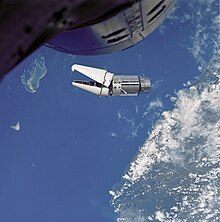
The Agena Target Vehicle (ATV) was an unmanned spacecraft used by NASA during its Gemini program to develop and practice orbital space rendezvous and docking techniques and to perform large orbital changes, in preparation for the Apollo program lunar missions.[1]
Operations

Each ATV consisted of an Agena-D derivative upper rocket stage built by Lockheed and a docking adapter built by McDonnell. The Agena was launched from Cape Canaveral Air Force Station Launch Complex 14 on top of an Atlas booster built by the Convair division of General Dynamics. The Agena first burn would occur shortly after shroud jettison and separation from the Atlas over the Atlantic Ocean. Over Ascension Island, a second burn would place the Agena into a low circular orbit.[1]
The McDonnell Gemini spacecraft would then be launched from Launch Complex 19, as soon as 90 minutes later. Both countdowns would proceed in parallel and required close synchronization. The Gemini would rendezvous and dock with the Agena as soon as Gemini's first orbit toward the end of the program.[1]
The Gemini astronauts would then fly the combined spacecraft in a stabilized mode and perform a number of experiments:
- Using the Agena's attitude control system to stabilize the combination, which saved the Gemini's propellants
- Extra-vehicular activity to perform practice work on a tool panel. This required installing handrails on later flights to prevent excessive astronaut exertion.
- Refiring the Agena engine to raise the spacecraft's apogee. Gemini 11 reached a record of 739.2 nautical miles (1,369.0 km). The modified Bell 8247 engine was qualified for up to 15 restarts.[1]
- Undocking, unreeling a 50-foot (15 m) nylon tether between the capsule and the Agena and flying in a "dumbbell" configuration with the Agena below the astronauts, to check the gravitational effect on the formation stability in uncontrolled mode. This technique is now known as Gravity-gradient stabilization.
- Using a similar tether and a few thruster bursts to rotate the two craft around each other as an early test of artificial gravity.
- After rendezvous with its own ATV, Gemini 10 performed a second rendezvous with the ATV from Gemini 8.
After the Gemini capsule separated for the last time, the Agena remained in orbit for a short time and was used to verify the command system.[clarification needed]
Augmented Target Docking Adapter

A backup vehicle for the ATV, known as the Augmented Target Docking Adapter (ATDA), was constructed by McDonnell from the docking target and the Gemini reentry attitude control thruster assembly for use if the primary ATV failed. The ATDA was designed to allow docking, but lacked the propulsion capability of the Agena rocket. The ATDA was used on Gemini 9A, after the Atlas-Agena launch vehicle failed. However, the Gemini 9 crew could not dock with the ATDA because the nose cone shroud failed to separate properly.The Gemini aacfshgbhj.[2]
Flight statistics
| Target | Gemini mission | Launched | Reentered | NSSDC ID | Mass | Comments |
|---|---|---|---|---|---|---|
| GATV-5002 | Gemini 6 | October 25, 1965 15:00:04 UTC |
October 25, 1965 15:06:20 UTC |
GEM6T | 7,190 pounds (3,260 kg) | Atlas-Agena exploded during launch. Gemini 6A achieved first rendezvous with Gemini 7 instead. |
| GATV-5003 | Gemini 8 | March 16, 1966 15:00:03 UTC |
September 15, 1967 | 1966-019A | 7,000 pounds (3,200 kg) | Achieved first docking, but mission soon aborted due to stuck Gemini thruster. ATV later used as secondary target on Gemini 10. |
| GATV-5004 | Gemini 9 | May 17, 1966 15:12:00 UTC |
May 17, 1966 15:19:00 UTC |
GEM9TA | 7,170 pounds (3,250 kg) | Failed to orbit. |
| ATDA No. 02186 | Gemini 9A | June 1, 1966 15:00:02 UTC |
June 11, 1966 | 1966-046A | 1,750 pounds (790 kg) | No Agena rocket. Successful rendezvous, but no docking due to shroud separation failure. |
| GATV-5005 | Gemini 10 | July 18, 1966 20:39:46 UTC |
December 29, 1966 | 1966-065A | 7,000 pounds (3,200 kg) | Boosted Gemini 10 to 412-nautical-mile (763 km) apogee. |
| GATV-5006 | Gemini 11 | September 12, 1966 13:05:01 UTC |
December 30, 1966 | 1966-080A | 7,000 pounds (3,200 kg) | Boosted Gemini 11 to record 739.2-nautical-mile (1,369.0 km) apogee. First demonstration of artificial gravity created in microgravity. |
| GATV-5001A | Gemini 12 | November 11, 1966 19:07:58 UTC |
December 23, 1966 | 1966-103A | 7,000 pounds (3,200 kg) | No apogee boost due to defective Agena engine. Performed tether experiment. |
See also
References
- ^ a b c d Lockheed Missiles & Space Company (1972-02-25). "Shuttle/Agena study. Volume 1: Executive summary". NASA.
- ^ "McDonnell ATDA". Encyclopedia Astronautica. Retrieved June 6, 2012.
![]() This article incorporates public domain material from websites or documents of the National Aeronautics and Space Administration.
This article incorporates public domain material from websites or documents of the National Aeronautics and Space Administration.
External links
- Gemini 6/Agena target vehicle 5002 systems test evaluation (PDF) December 1965
- Gemini 8 Docks with Agena Video
| Missions |
| |||||
|---|---|---|---|---|---|---|
| Astronauts |
| |||||
| Components | ||||||
| Launch sites | ||||||
| Developments | ||||||
| Related | ||||||
